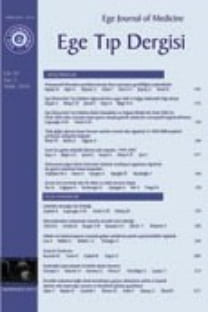Crohn hastalığı ve EÜTF Proktoloji Bilim Dalı deneyimi
Crohn's disease and Ege University School of Medicine Proctology Department experience
___
- 1) Dietz D, Lauretti S, Strong SA et al. Safety and long-term efficacy of strictureplasty in 314 patients with obstructing small bowell Crohn's disease. J Am Coll Surg 2001; 192:330-7.
- 2) Devecioğlu S, Savaşan MK, Kaya M. Granülomatöz Kolit. Sayek I. Temel Cerrahi. Güneş Kitabevi-Ankara 2. baskı 1996;1118-23
- 3) Best WR, Becktel JM, Singleton JW et all. Development of a Crohn's disease activity index. Gastroenterology 1979;77:829-42
- 4) Wolff BG. Surgery for distal small bowel, colonic and anorectal Crohn's disease. Surgery of the alimentary tract. W B Saunders Co. 2002 Fifth Edition Vol 4 Chapter 9 pp 105-116.
- 5) Evers BM. Townsend Jr CM. Thompson JC. Small Intestine. Schwartz SI. Principles of Surgery. McGraw-Hill Co. Seventh Edition. 1999;pp1217-63.
- 6) Milsom JW. Laparoscopic surgery in the treatment of Crohn's disease. Surg. Clin N Am 85(2005) 25-34.
- 7) Sachar DB. Maintenance strategies in Crohn's disease. Hosp Pract 1996; 1599-606.
- 8) Farmer RG, Whelan G, Fazio VW. Long-term follow-up patients with Chron's disease: relationship between clinical pattern and prognosis. Gastroentrology 1985; 88:1818-25.
- 9) Keighley MRB. Surgical treatment of small bowell Crohn's disase. Keighley MRB. Surgery of the anus, rectum and colon.W B Saunders. 1993, 1710-1756.
- 10) Katariya RN, Rao PG, Rao PL. Strictureplasty for tuercular strictures of the gastritestinal tract. Br J Surg 1977; 64:496.
- 11) Michelassi F, Balestracci T, Chappell R, et al. Primary and reccurent Crohn's disease: Experience with 1379 patients Ann Surg 1991; 3:230-8.
- 12) Williams JG, Wong WD, Rothenberger, et al. Reccurence of Crohn's disease after resection. Br J Surg 1991; 78:10-9.
- 13) Nordgren SR, Fasth SB, Oreslan TO, et al. Long term follow-up in Crohn's disease. Mortality, morbidity and functional status. Scan J Gastroenterol 1994; 29:1122-8.
- 14) Akyüz A. Bilsel Y. Crohn Hastalığı. Alemdaroğlu K. Kolon Rektum ve Anal Bölge Hastalıkları. 1. baskı İstanbul, Ajans Plaza Tanıtım ve İletişim Hizm.Ltd. Şti. 2003, 621-644.
- 15) Ozuner G, Fazio VW, Lavery IC et al. How safe is strictureplasty in the management of Crohn's disease. Am J Surg 1996; 171:57-61.
- 16) Hurst RD, Michelassi F. Strictureplasty for Crohn's disease techniques and long term results. World J Surg 1998; 22:359-63.
- 17) Milsom JW. Strictureplasty and mechanical dilatation in strictured Crohn's disease. In Michelassi F, Milsom JW, ods. Operative strategies in inflammatory bowel disease. New York:Springer Verlag; 1999: 259-267.
- 18) Hurst RD. Management of small bowel Crohn's disease. Prob Gen Surg 1999; 16: 58.
- 19) Michelassi F. Side-to-side isoperistaltic strictureplasty for multipl Crohn's stricture. Dis Colon Rectum 1996; 39:345-9.
- 20) Spencer MP, Nelson H, Wolff BG. Strictureplasty for obstructive Crohn's disease: the Mayo experience. Mayo Clin Proc 1994; 69:33-6.
- 21) Fazio VW, Tijandra JJ, Lavery IC, et al. Long-term follow-up of strictureplasties in Crohn's disease. Dis Colon Rectum 1993; 36:355-61.
- 22) Evans J. Poritz L. mcRae H. Influence of experience on laparoscopic ileocolic resection for Crohn's disease.Dis Colon Rectum 2002;45:1595-600
- 23) Ogunbiyi OA. Fleshman JW. Place of laparoscopic surgery in Crohn's disease. Baillieres Clin Gastroenterol 1998;12:157-65
- 24) Cohen Z, Sabo G, McLoad RS. İnflamatory Bowel Disease. Surgery of the alimentary tract. W B Saunders Co. 2002 Fifth Edition Vol 4 Chapter 7 pp 66-83
- 25) Andreas HA, Keighley MR, Alexander-Williams J, et al. Strategy for management of distal ileal Crohn's disease. Br J Surg 1991; 78:679-82.
- 26) Hellers G. Crohn's disease in Stockholm county. Acta Chir Scan 1979; 490:31-69.
- 27) Yamamato T, Keighley MRB. Factors effecting the incidence of postoperative septic complications and recurence after strictureplasty for jejunoileal disease.Am J Surg 1999;178:240-45
- ISSN: 1016-9113
- Yayın Aralığı: 4
- Başlangıç: 1962
- Yayıncı: Ersin HACIOĞLU
Büket KOSOVA, Z. EROĞLU, B. YILMAZ, C. GÜNDÜZ, R. ÖZEL, E. SAYIN, Ö. ÇOĞULU, F. ÖZKINAY, C. ÖZKINAY, N. TOPÇUOĞLU
Mediastinal ostesarkom metastazı
Banu AKTİN, U. ÇAĞIRICI, A. ÇAKAN, A. VERAL
Wolfram sendromu tanısı alan iki kardeş olgunun retrospektif incelemesi
Mehmet DAVUTOĞLU, H. KARABİBER, E. GÜLER, D. ÇITIRIK, A. ÖZBEK
Ewing sarkomunda prognoz klinik ve histolojik bulgular ile belirlenebilir mi?
Kutsal TURHAN, B. YOLDAŞ, Ö SAMANCILAR, A. ÇAKAN, U. ÇAĞIRICI
U. AYDIN, Pınar YAZICI, L. YENİAY, M. ÖZSOY, A. ÇOKER
Gül KİTAPÇIOĞLU, E. YANIKKEREM
Succesfull thyroid cancer surgery in Glanzmann's disease: Report of a case
Özer MAKAY, Ö. KIRDÖK, G İÇÖZ, M. AKYILDIZ, E. YETKİN
Annelerin sünnet hakkındaki davranış ve bilgi düzeylerinin incelenmesi
Y. YILMAZ, S.A. ÖZSOY, Melek ARDAHAN
Üniversite öğrencilerinin bilgisayar kullanımına birey sağlığı kapsamında genel bakış açıları
